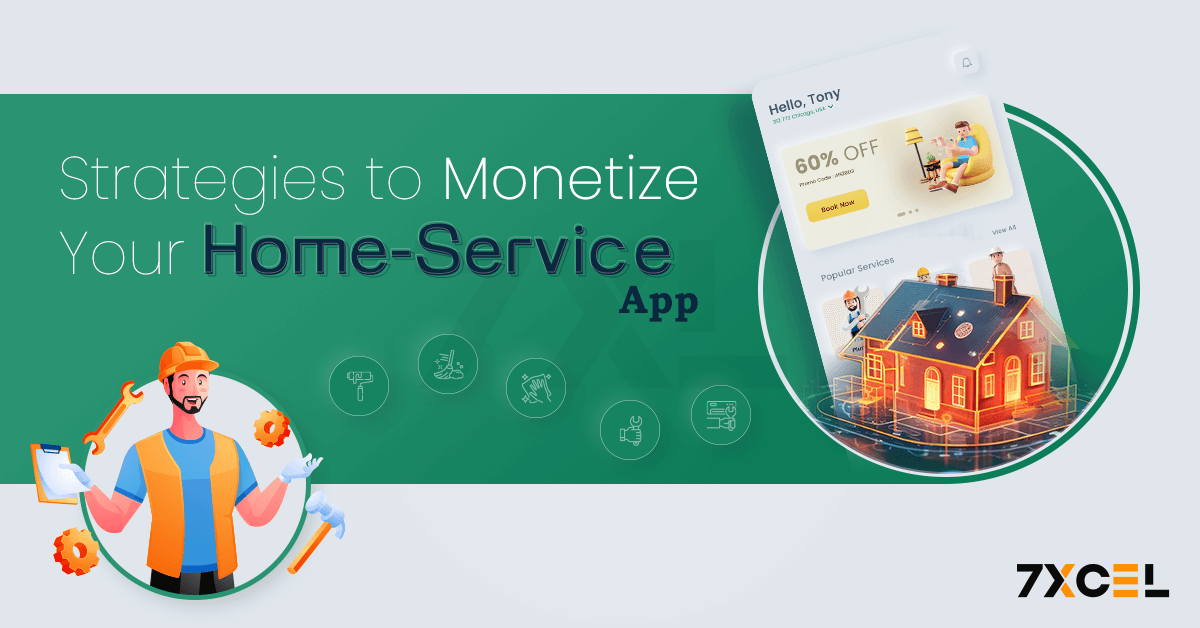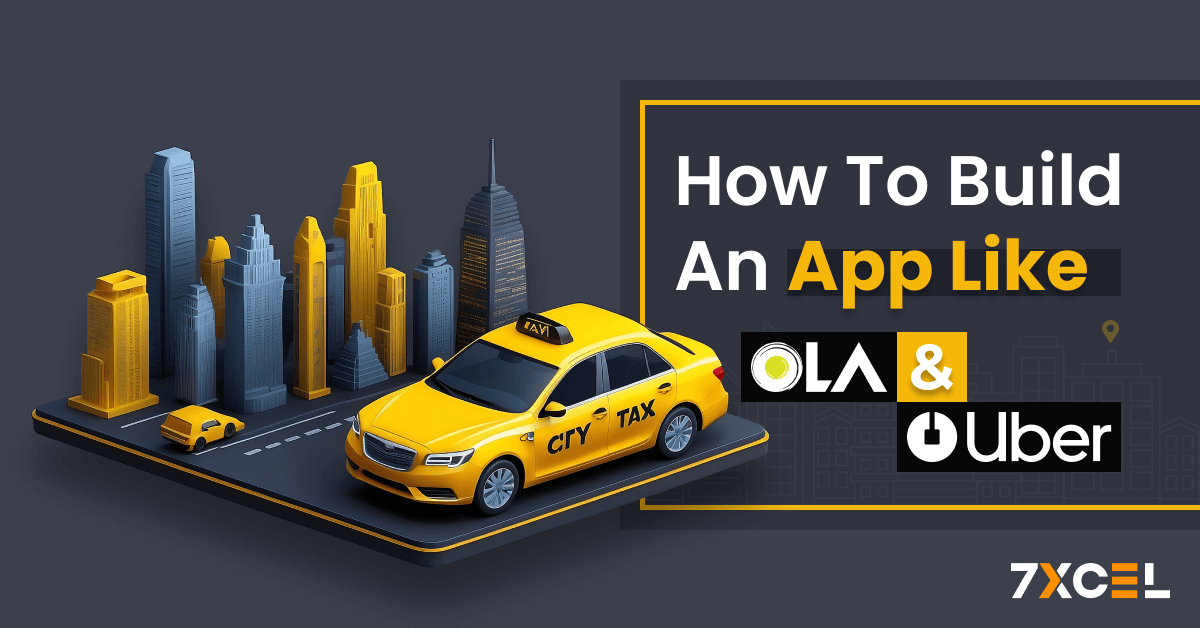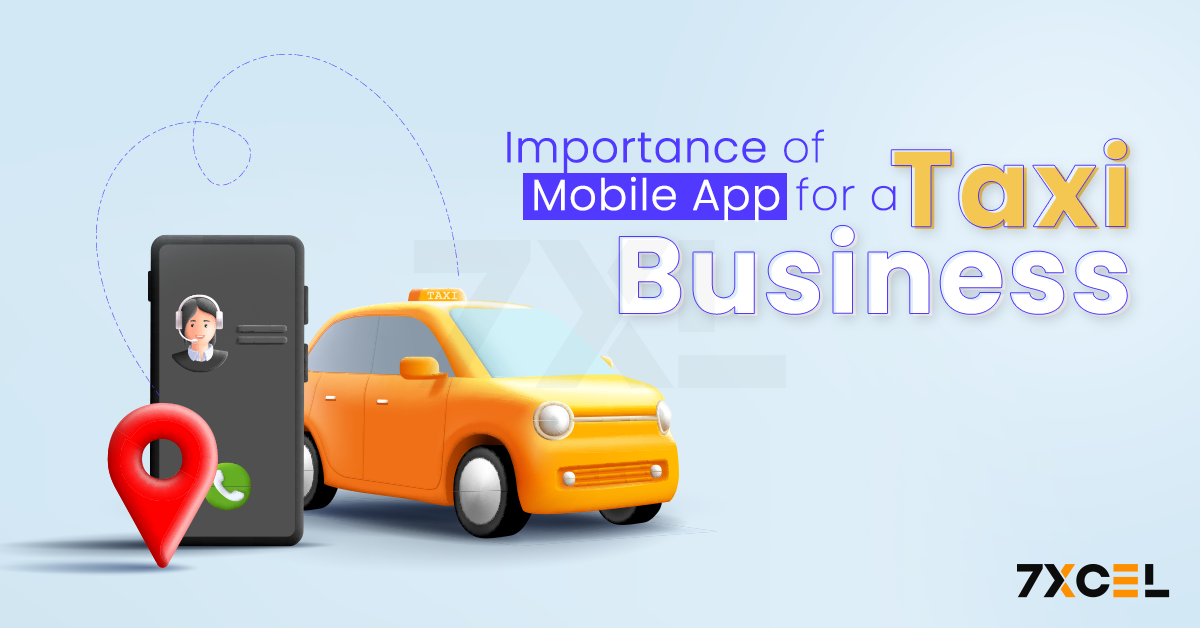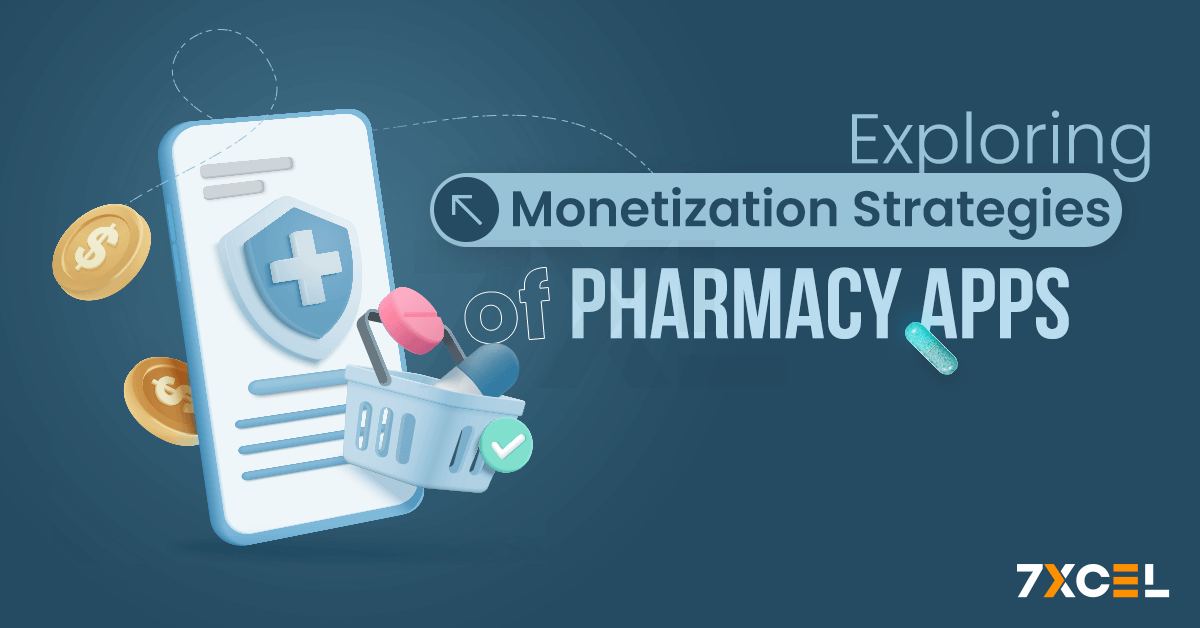Quick Summary:
The home services industry is a rapidly growing market, and launching a successful home services app can be a lucrative opportunity. However, effectively monetizing the app is crucial for long-term sustainability and profitability. This blog post explores six key strategies to monetize your home services app, including commission-based models, freemium models with in-app purchases, subscription models, advertising and sponsorships, tiered pricing and service packages, and a focus on user satisfaction and retention.
In this blog, we’re going to discuss📝
The convenience of digital platforms and the rising need for on-demand services have propelled the market for home-service apps to significant development in recent years. According to a report by Grand View Research, The size of the worldwide market for online on-demand home services was projected to be USD 3.71 billion in 2021, and it is anticipated to increase at a 16.7% compound annual growth rate (CAGR) between 2022 and 2030. This surge is attributed to the growing preference for time-saving and hassle-free services, especially among urban populations.
As competition in the market intensifies, finding effective monetization strategies becomes paramount. Successful monetization not only generates revenue but also enhances user experience and satisfaction. This blog explores the key strategies for monetizing a home-service app, providing a roadmap for turning your platform into a profitable business.
How to Monetize a Home Service App: Effective Strategies for Generating Revenue
The home service app industry has transformed how consumers book and manage various services such as cleaning, repairs, and maintenance. It’s essential to in order to succeed in this cutthroat environment implement effective monetization strategies that not only increase user engagement and satisfaction but also make money. This blog will explore key strategies for monetizing a home service app, providing insights into creating sustainable income streams and maximizing profitability.
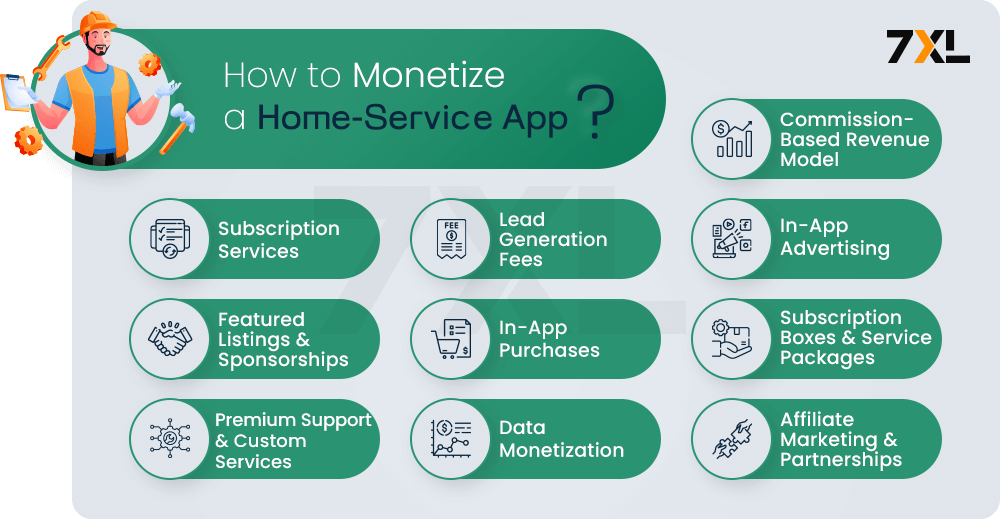
1. Commission-Based Revenue Model
The commission-based model is one of the most common and effective ways to monetize a home service app. It involves charging service providers a percentage of each transaction they complete through the app.
How It Works:
- Transaction Fee: Service providers pay a commission to the app for each job booked and completed. This fee is typically a percentage of the total service cost and can range from 10% to 30%.
- Variable Commissions: The commission rate can vary depending on the type of service, location, or provider rating. Higher commissions might be charged for premium services or in high-demand areas.
Advantages:
- Scalable Revenue: As the number of transactions increases, so does the revenue, making it a scalable and profitable model.
- Low Entry Barrier: Encourages a large number of service providers to join the platform due to minimal upfront costs.
Disadvantages:
- Provider Resistance: High commission rates might deter service providers, especially if they feel it cuts into their profits too much.
- Customer Pricing Impact: Providers may pass on the commission costs to customers, potentially leading to higher service prices.
Examples:
- TaskRabbit: Charges a service fee from each transaction between customers and service providers, usually ranging from 15% to 30%, depending on the service and location.
2. Subscription Services
Subscription services offer a steady revenue stream by providing users and service providers with access to exclusive features or benefits for a recurring fee. This model helps ensure consistent income while enhancing user loyalty and engagement.
How It Works:
- User Subscriptions: Customers can subscribe to monthly or yearly plans that provide benefits such as discounted rates, priority booking, or access to premium services.
- Provider Subscriptions: Service providers pay for access to advanced features like enhanced visibility, performance analytics, and priority customer inquiries.
Advantages:
- Predictable Revenue: Generates consistent income through regular subscription payments, aiding in financial planning and stability.
- Increased Retention: Subscribers are likely to stay engaged with the app to maximize their benefits, leading to higher retention rates.
Disadvantages:
- Conversion Challenge: Convincing free users to upgrade to paid subscriptions can be difficult and requires compelling value propositions.
- Churn Risk: Retaining long-term subscribers can be challenging, particularly if users do not perceive ongoing value in the subscription.
Examples:
- Handy: Offers subscription plans for users to access discounted rates and priority booking for various home services, including cleaning and handyman services.
3. Lead Generation Fees
Charging service providers for leads is an effective way to generate revenue while providing them with valuable business opportunities. This model is particularly beneficial for new or less established providers looking to expand their customer base.
How It Works:
- Pay-Per-Lead: Service providers pay a fee for each lead or customer inquiry they receive through the app. The fee can be a flat rate or based on the potential service value.
- Quality Leads: Leads can be categorized by their likelihood to convert, with higher-quality leads commanding higher fees.
Advantages:
- Revenue Generation: Provides a steady income stream from providers eager to gain new business leads.
- Provider Benefits: Offers providers a direct path to potential customers, increasing their chances of securing jobs and earning income.
Disadvantages:
- Lead Quality: Ensuring leads are high quality and likely to convert can be challenging, as poor-quality leads may lead to provider dissatisfaction.
- Competitive Costs: High lead fees might discourage smaller or less established providers from participating.
Examples:
- Thumbtack: Charges service providers for each lead they receive, with fees varying based on the type of service and location.
4. In-App Advertising
In-app advertising offers a significant revenue opportunity by displaying ads from third-party businesses within the app. This model leverages the app’s user base to generate income through various ad formats.
How It Works:
- Ad Placements: Advertisements such as banners, pop-ups, and video ads are strategically placed within the app. Advertisers pay for these placements based on impressions, clicks, or conversions.
- Targeted Ads: The app can use user data to display relevant ads that match user interests and needs, increasing ad effectiveness.
Advantages:
- Additional Revenue: Provides a lucrative income stream without directly charging users for accessing the app’s services.
- Brand Partnerships: Creates opportunities for collaborations with brands that align with the app’s services and target audience.
Disadvantages:
- User Experience Impact: Excessive or intrusive ads can disrupt the user experience and lead to dissatisfaction and potential app abandonment.
- Ad Relevance: Ensuring ads are relevant and non-disruptive is crucial to maintain user engagement and trust.
Examples:
- Angi (formerly Angie’s List): Generates revenue through in-app ads from home service providers and related businesses, offering targeted advertising options to its extensive user base.
5. Featured Listings and Sponsorships
Featured listings and sponsorships involve charging service providers for premium placement within the app. This strategy increases the visibility of providers, leading to more bookings and generating additional revenue for the app.
How It Works:
- Priority Listings: Providers pay to have their services featured prominently in search results or on the app’s homepage, increasing their visibility and customer inquiries.
- Sponsored Content: Providers can sponsor specific service categories or areas within the app, offering them enhanced visibility and higher engagement.
Advantages:
- Increased Visibility: Gives providers a competitive edge that aids in consumer attraction and business expansion.
- Consistent Income: Generates a steady income stream from providers willing to invest in premium placements to boost their visibility.
Disadvantages:
- Fairness Concerns: Overemphasis on paid placements might lead to perceptions of unfair advantage and affect the app’s credibility among users.
- Balance Needed: The app must balance paid and organic listings to ensure a fair and trustworthy user experience.
Examples:
- TaskRabbit: Offers featured listings for service providers who want to increase their visibility in specific service categories or geographic areas, driving more customer interactions and bookings.
6. In-App Purchases
In-app purchases allow users and service providers to buy virtual goods or access additional features within the app. By giving consumers the option to improve their experience through microtransactions, this approach offers a flexible source of revenue.
How It Works:
- User Enhancements: Users can purchase features like additional booking slots, priority customer support, or virtual gifts for service providers.
- Provider Tools: Service providers can buy tools to improve their service delivery, such as advanced scheduling tools, customer management features, or marketing resources.
Advantages:
- Immediate Revenue: Generates instant income from users and providers looking to enhance their app experience.
- User Choice: Allows users and providers to customize their experience by purchasing only the features they find valuable.
Disadvantages:
- User Resistance: Some users may be reluctant to pay for features that they feel should be included for free, leading to potential dissatisfaction.
- Complex Management: Managing a variety of in-app purchases and ensuring they provide clear value can be challenging.
Examples:
- UrbanClap (now Urban Company): Offers in-app purchases for users to buy additional services or upgrades, such as express booking or premium customer support.
7. Subscription Boxes and Service Packages
Offering subscription boxes or service packages provides a recurring revenue model that bundles multiple services into a convenient, cost-effective package for users. This model appeals to customers who require regular home services and prefer a bundled solution.
How It Works:
- Service Packages: Users can subscribe to a package that includes a set number of services each month, such as weekly cleaning or monthly maintenance checks.
- Subscription Boxes: The app can offer subscription boxes containing home maintenance products or tools, providing users with everything they need for DIY tasks.
Advantages:
- Recurring Revenue: Generates steady income through regular subscription payments, providing financial predictability.
- Customer Convenience: Offers a convenient and cost-effective solution for users who need regular home services, enhancing user satisfaction and retention.
Disadvantages:
- Service Management: Coordinating and managing recurring services requires effective logistics and customer relationship management.
- Subscription Fatigue: Some users may tire of recurring payments, leading to potential churn if they no longer perceive value in the subscription.
Examples:
- HomeAdvisor: Offers service packages that bundle various home maintenance services into a monthly or annual subscription, providing users with cost savings and convenience.
8. Premium Support and Custom Services
Providing premium support and custom services offers a way to monetize additional customer care and specialized service requests. This model caters to users willing to pay for personalized assistance and higher levels of service.
How It Works:
- Premium Support: Users can pay for access to priority customer support, including faster response times, dedicated support agents, and extended service hours.
- Custom Services: The app can offer custom service options for users with specific needs or requests, such as personalized home improvement plans or bespoke cleaning schedules.
Advantages:
- Enhanced Revenue: Provides an additional income stream from users who value premium support and customized services.
- User Satisfaction: Increases user satisfaction by offering tailored solutions and high-quality support, leading to higher retention rates.
Disadvantages:
- Resource Intensive: Providing premium support and custom services requires significant investment in staff and resources to ensure high service standards.
- Cost Perception: Some users may perceive premium services as too expensive, limiting the market size for these offerings.
Examples:
- Angi (formerly Angie’s List): Offers premium support options for users who require personalized assistance and custom service solutions for their home maintenance needs.
9. Data Monetization
Data monetization involves analyzing and selling anonymized user data to third parties for research, marketing, or development purposes. This model leverages the valuable data collected through user interactions with the app.
How It Works:
- Data Analysis: The app collects and analyzes data on user behavior, service preferences, and demographics.
- Data Sales: Aggregated and anonymized data is sold to third parties for market research, product development, or targeted marketing campaigns.
Advantages:
- High Value: User data provides valuable insights for businesses looking to understand consumer behavior and trends in the home service market.
- Non-Disruptive: Generates revenue without directly impacting the user experience, making it an attractive option for additional income.
Disadvantages:
- Privacy Concerns: Requires strict compliance with privacy regulations and ethical guidelines to avoid legal issues and maintain user trust.
- User Trust: Maintaining user trust is critical, as data monetization practices can raise concerns about data privacy and security.
Examples:
- Handy: Could sell anonymized data to home improvement stores or market research firms to help them understand trends in home-service needs and consumer preferences.
10. Affiliate Marketing and Partnerships
Affiliate marketing and partnerships involve promoting products or services from partner companies within the app and earning a commission on sales generated through referrals. This model provides an additional revenue stream and enhances the app’s value proposition.
How It Works:
- Product Promotions: The app features products or services from affiliate partners, and users can purchase these items through referral links.
- Commission Earnings: The app earns a commission for each sale made through its referral links, providing a steady income stream.
Advantages:
- Revenue Sharing: Generates additional income without significant investment in new content or features.
- Extended Offerings: Enhances the app’s value by promoting relevant products and services that align with user needs.
Disadvantages:
- Quality Control: Ensuring that affiliate products meet the app’s quality standards is crucial to maintain user trust and satisfaction.
- Revenue Split: The revenue is shared with partners, potentially reducing overall profitability.
Examples:
- Thumbtack: Could promote home improvement products from partner companies, earning commissions on sales through affiliate links.
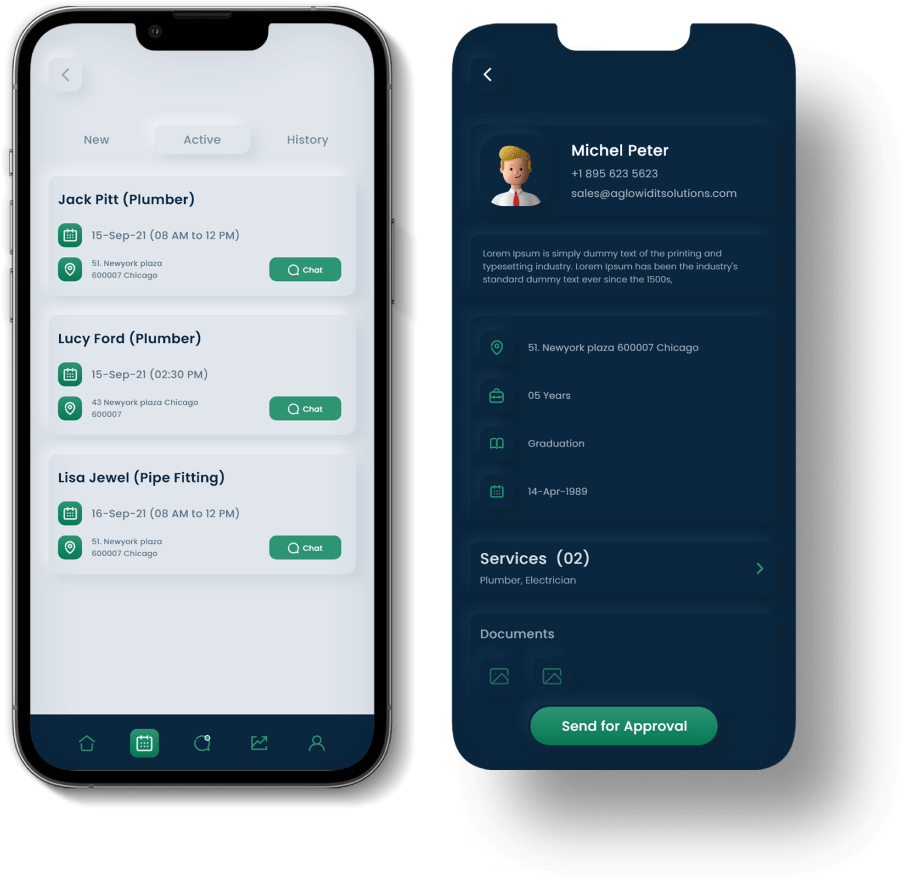
In Need of Home Services App Development Solutions?
Opt for custom on-demand home services app development services from 7xcel, tailored to streamline your everyday household needs.
Tips for Maximizing Your Handyman App Revenue: Strategies for Success
The handyman services industry has seen significant growth, thanks to the convenience and accessibility offered by mobile apps. Partnering with a specialized Home Service App Development Company can help you build a robust and user-friendly platform tailored to this market.
These experts can assist in implementing features like real-time booking, secure payment options, and service provider ratings, which are crucial for attracting and retaining users. To maximize revenue for your handyman app, you need to implement effective strategies that cater to both service providers and customers. Here are some essential tips to help you optimize your app’s revenue potential and ensure long-term success.
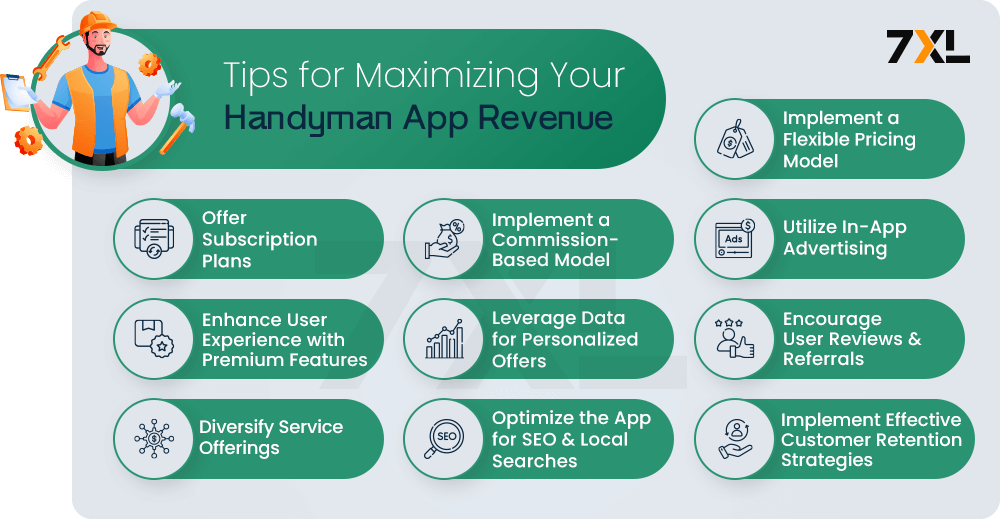
1. Implement a Flexible Pricing Model
Offering flexible pricing options can attract a diverse customer base and accommodate varying budgets. It allows you to cater to both budget-conscious users and those willing to pay for premium services.
Strategies:
- Dynamic Pricing: Adjust prices based on demand, time of day, or service type. For example, higher rates during peak times or for urgent requests can increase revenue.
- Tiered Services: Provide different service levels (e.g., basic, standard, premium) with corresponding price points. This can cater to users with different needs and budgets.
- Special Discounts: Offer discounts for first-time users, referrals, or bulk bookings. This can encourage more frequent use and attract new customers.
Benefits:
- Increased User Base: Flexible pricing can attract a wider range of customers, from those seeking affordable options to those willing to pay more for premium services.
- Revenue Growth: Dynamic and tiered pricing can maximize revenue by aligning with customer willingness to pay.
2. Offer Subscription Plans
Subscription plans provide a steady revenue stream by charging customers a recurring fee for access to exclusive benefits or premium features.
Strategies:
- Membership Plans: Introduce monthly or annual subscription plans that offer benefits like discounted rates, priority booking, or free service add-ons.
- Service Packages: Bundle multiple services into a subscription plan (e.g., monthly maintenance packages) to encourage regular use and long-term commitment.
Benefits:
- Consistent Revenue: Recurring subscription payments provide a reliable income source.
- Enhanced Loyalty: Subscriptions encourage users to stay engaged with the app to maximize their benefits, leading to higher retention rates.
3. Implement a Commission-Based Model
Charging service providers a commission for each job booked through the app is a straightforward way to generate revenue. This model aligns the app’s success with the volume of transactions.
Strategies:
- Commission Rates: Set competitive commission rates that balance profitability with attractiveness to service providers. Consider varying rates based on service type or provider experience.
- Performance Bonuses: Offer reduced commission rates or bonuses for top-performing providers to incentivize high-quality service and repeat business.
Benefits:
- Scalable Income: As the number of completed jobs increases, so does the revenue, making it a scalable model.
- Provider Incentives: Performance-based incentives encourage high-quality service, leading to customer satisfaction and repeat bookings.
4. Utilize In-App Advertising
In-app advertising can generate significant revenue by displaying ads from third-party businesses. Leveraging the app’s user base for targeted advertising can create a valuable income stream.
Strategies:
- Ad Placements: Incorporate unobtrusive ads within the app, such as banners or sponsored content, that are relevant to the user’s needs.
- Targeted Ads: Use user data to display personalized ads that match their interests, increasing ad engagement and effectiveness.
Benefits:
- Additional Revenue: In-app ads provide a substantial income source without charging users for access.
- Brand Partnerships: Advertising offers opportunities for partnerships with brands that align with the app’s services.
5. Enhance User Experience with Premium Features
Offering premium features can improve user experience and justify higher charges or additional fees. Enhanced features can cater to users looking for more convenience or advanced functionalities.
Strategies:
- Priority Support: Offer priority customer support or faster response times for a fee, providing users with added convenience.
- Advanced Booking Options: Allow users to schedule multiple jobs or recurring services in advance, with premium access to top-rated providers.
Benefits:
- Increased Revenue: Premium features provide an additional revenue stream by catering to users willing to pay for enhanced services.
- User Satisfaction: High-quality, convenient features can improve user satisfaction and retention.
6. Leverage Data for Personalized Offers
Using data analytics to understand user behavior and preferences can help you create personalized offers that drive engagement and revenue.
Strategies:
- User Insights: Analyze user data to identify trends and preferences, such as frequently booked services or preferred service times.
- Customized Promotions: Send personalized offers or discounts based on user history, encouraging repeat bookings and loyalty.
Benefits:
- Targeted Marketing: Personalized offers are more likely to resonate with users, leading to higher engagement and conversion rates.
- Enhanced User Experience: Tailoring services and promotions to individual needs improves user satisfaction.
7. Encourage User Reviews and Referrals
Positive reviews and referrals can boost your app’s reputation and attract new users, increasing revenue opportunities.
Strategies:
- Incentivize Reviews: Offer discounts or credits for users who leave reviews, helping to build a positive online reputation.
- Referral Programs: Implement referral bonuses that reward users for bringing new customers to the app.
Benefits:
- Increased Visibility: Positive reviews enhance the app’s credibility and attract new users.
- Organic Growth: Referral programs can drive user acquisition at a lower cost compared to traditional marketing.
8. Diversify Service Offerings
Expanding the range of services offered can attract a broader user base and create new revenue streams. Consider adding complementary services that align with your existing offerings.
Strategies:
- Service Expansion: Introduce new services such as landscaping, pest control, or home renovations to complement existing handyman services.
- Seasonal Offerings: Offer seasonal services like winterization or holiday decorating to meet timely user needs.
Benefits:
- Increased Revenue: More service options can attract a wider range of customers and increase the frequency of bookings.
- User Retention: Providing a comprehensive suite of services encourages users to rely on the app for multiple needs, improving retention.
9. Optimize the App for SEO and Local Searches
Enhancing your app’s visibility in search engines and local searches can drive organic traffic and increase user acquisition, leading to more bookings and higher revenue.
Strategies:
- Local SEO: Optimize the app for local keywords and services to appear in searches for handyman services in specific areas.
- Content Marketing: Create content that highlights your app’s services and benefits, attracting users through informative articles and blog posts.
Benefits:
- Organic Growth: Improved SEO leads to higher visibility and more organic user acquisition.
- Local Engagement: Targeting local searches can increase relevance and attract users looking for nearby services.
10. Implement Effective Customer Retention Strategies
Retaining existing users is more cost-effective than acquiring new ones. Focus on strategies that encourage repeat usage and long-term loyalty.
Strategies:
- Loyalty Programs: Reward users with points or discounts for repeat bookings, encouraging them to continue using the app.
- Personalized Follow-Ups: Send personalized follow-up messages or offers to users after service completion, enhancing their experience and encouraging future bookings.
Benefits:
- Higher Lifetime Value: Retained customers contribute more to long-term revenue through repeat bookings and loyalty.
- Reduced Churn: Effective retention strategies decrease user churn, ensuring a steady user base.
Conclusion
Creating a home service app can transform your service delivery and customer engagement. By Leveraging 7xcel’s expertise in home app development, you can develop a scalable and user-friendly platform that meets the needs of both service providers and clients. To monetize the app effectively, employ a mix of revenue models such as commission-based fees, subscriptions, in-app advertising, and premium services. The right combination will depend on your target market and competitive landscape, ensuring a sustainable and profitable business model in the home service industry.
